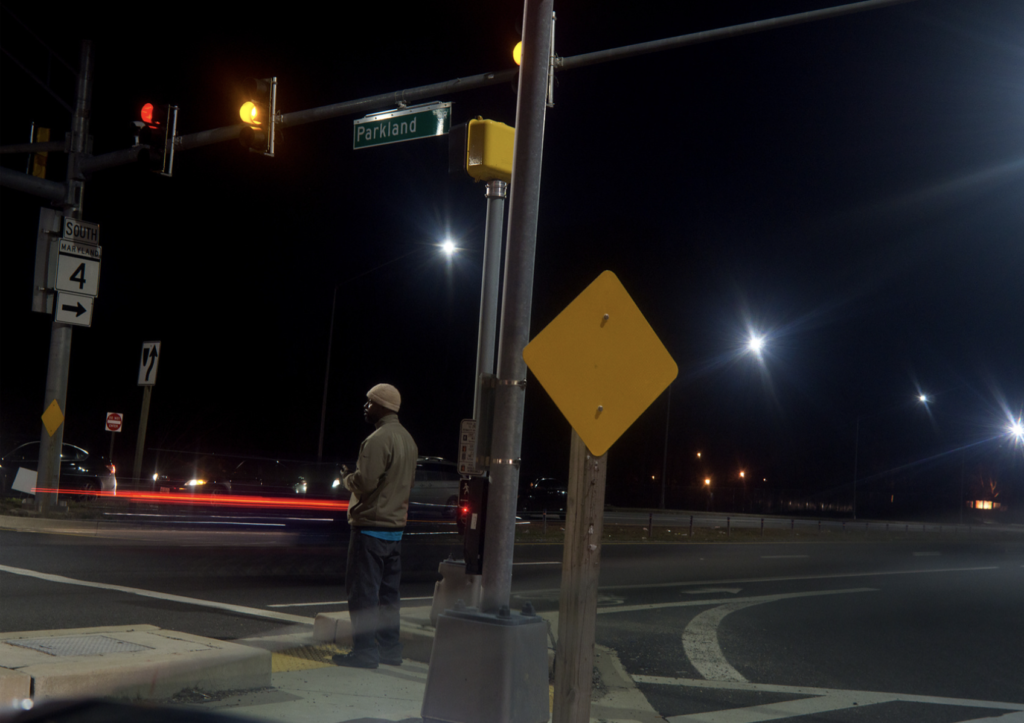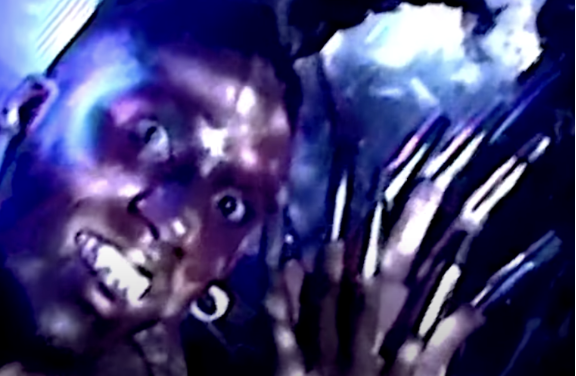by RAMON JOHNSON

“If the sublime is a subjective experience evoked by spectacles that seem dangerous in their magnitude or power, swamps are quintessentially sublime spaces, because they are vast geographies that defy measurement.”
M. Allewaert[1]
Black queer and trans art performs a refusal of assimilation and generates conceptions of being that lean into the areas that embrace monstrosity and go beyond the human in order to resist (anti)Black logics of being sometimes at the risk of being read as illegible. The fortitude of these artists alongside their commitment to upending and inventing at the edge of legibility while also resisting the masculinist genre norms of rap provides new possibilities for Black folks to be made anew.
The artist Blu Bone embodies and refuses certain norms and aspects of the rap genre. For example, unlike many rap videos, Blu Bone’s “Wicked Womb” confronts slavery and colonialism’s past and current manifestations which Zakiyyah Iman Jackson asserts “catalyzed the conscription of Black people into imperialist and racialized conceptions of modernity and universal humanity…that have given rise to a transnational, capitalist order.”[2] Blu’s gender expression shows us that these paradoxical symbols of manhood are not the only aspects of masculinity available to him. As I will demonstrate, in this video, the recurring phrase, “is there enough room in this wicked womb” and Blu Bone’s almost otherworldly persona takes on a potent quality that distinguishes his sound, which the artist describes as “high cotton.” According to Blu, in the Mississippian lexicon “high cotton” means “of the highest quality and pleasure.” Yet, to the western eye, “Wicked Womb” may invoke fear considering how Blu Bone’s persona leans into an almost “monstrous” aesthetic.

In today’s popular culture, screenwriters and cultural producers may be hesitant or nervous about portraying Blackness through nonhuman or otherworldly characters due to our country’s (anti)Black history of categorizing Black people as such. The pickaninny and minstrel shows are just a few examples. To be honest, I initially did not understand Blu’s intent while he portrayed his own being in a nonhuman form. I wrestled with questions regarding representation as well. What is the purpose of showcasing Blackness through nonhuman and otherworldly figures? What does this image do to the Black psyche?
After much reflection and watching Blu Bone’s video multiple times, I realized this is a careful line that Blu is treading. More importantly, it is imperative that one be careful when deciphering Black cultural objects through western grammars. Failure to do so can risk misconstruing what is truly being embodied through (anti)Black western grammars and ways of knowing. Blu’s twisted locs with cotton at the ends, the glowing eyes, pointy teeth, references to muddy water, repeated strikes of lightning and hurricanes, and the unceasing beating of the African drum evokes something robust, potent, and almost ancestral. Is Blu Bone’s persona channeling a trickster[3] or indigenous/African deity? Is he pointing to the way the Black body can be twisted and contorted in an (anti)Black world? Blu might be doing both while also doing what Christina Sharpe calls “wake work.” The remains of Blu’s Mississippi roots in addition to his West African and Indigenous ancestry are on full display in monstrous form due to the terror of slavery and the silence of the archive.
It’s as if Blu or the trickster deity he is embodying is presiding over unknown muddy geographies where no one dares to enter. In a recent interview with Dazed, Blu shares that he is creating his own folklore. The unnamed deity we see in the music video, according to Blu, “escaped a lynching but was seemingly consumed by an alligator while crossing the Mississippi River.”[4] After resurfacing from the waters and transforming into a swamp monster deity, they commit themself to mutinying and liberating enslaved Africans on slave ships that cross where they preside. Instead of dying, they all resurface as these reptilian, hybrid, funky, free, swamp beings. These references and questions point to the incipient possibilities and the ways in which Blu is unsettling rather than reifying colonial logics of the human and racialized gendered identity. In African folklore and African Traditional Religions, the trickster can sometimes be an ungendered or gender fluid deity that acts as a vestibule of sorts between two worlds. In a way, Blu’s repeated questioning of space to exist and subsequent description of space as an “aquadoom” could be an acknowledgment of doubt and an acknowledgment of (anti)Blackness. In the words of Christina Sharpe, “the climate is (anti)Black.”
Taking this into consideration, the trickster has already or is in the process of making a space for themself to exist outside of binary logics of an earthly plane/afterlife. Blu asserts himself as the trickster in a middle area that transmutes from one world to another in a quasi-vestibule area that Blu may be naming as aquadoom. The circumstances of this aquadoom may easily be compared to C. Riley Snorton’s Snaky Swamp.[5] Or to Hartman’s “loophole of retreat,” which she defines as a “space of freedom that is at the same time a space of captivity.”[6] This vexed space of ongoing fugitivity stages the transversal relationship between Black life and Black death. However, Blu’s embodiment as a trickster deity that emerges in the muddy waters of an aquadoom may not map onto our current understandings of fugitivity considering how such a deity is no longer enslaved and has found refuge that is permanent, not temporary.
After viewing Blu Bone’s “Wicked Womb” it is clear that Blu is questioning what the being of Blackness is. Blu is also questioning how one can exist in a world where (anti)Blackness is constantly mutating. It appears that Blu is attempting to be born with multiple images of himself immersed in a womb or in water connected to an umbilical cord. (Anti)Blackness appears to be a matrix or womb functioning to limit the possibilities of the Black to survive. If (anti)Blackness is what Jackson also describes as “a womb…a binding substance or…a matrix,” then the normative conception of “the human” and the arrangements Blu Bone allegorizes have their source in abject Blackness.[7] Viewing images of the Black womb, whales, alligators and Blu’s femme gender performance reminds me of how scientists and philosophers have historically utilized the animal and human identity to construct Black femaleness, maternity, and sexuality as central to understandings of abject human animality.
Black maternity and the womb seems to be central in this video as well. The way in which we think about the ongoing afterlife of Blackness coming from the mother as a matter of law, culture, and history. The Moynihan Report exploited this by perpetuating the idea that pathology and deviance only comes from single mothers. This toxic report has helped perpetuate the (anti)Black idea that there is never a way to get out of the circumstances of Blackness or (anti)Blackness due to the generative power of the black mother and the womb. To be clear, “Wicked Womb” does not recycle this (anti)Black myth. Instead, Blu Bone is clear that the womb that is this world has an (anti)Black climate.
During the halfway mark of the video, we see Blu screaming in a room of glass and mirrors. His eyes are solid white and his body and locs are adorned with chrome chains and silver. Fanon reminds us there are psychological consequences to (anti)Blackness and whiteness that can easily impact a colonized subject. In fact, Fanon asserts, “ontology does not allow us to understand the being of Black people.”[8] Even though Blu does not appear to have the dependency complex Fanon speaks of, he does appear to question his ontology while also attempting to create a new self that is otherworldly. This work requires confrontation with dominant culture’s (anti)Black logics of the human, beauty and whiteness. Dominant culture constantly produces ideals that are damaging, ableist, and unattainable. Perhaps this space forces Blu to only contend with his reflection in order to take back his power and reclaim any and every thing society has tried to devalue about Blackness. This may carve out space for a deepening relationship with the mind, body, and soul.
